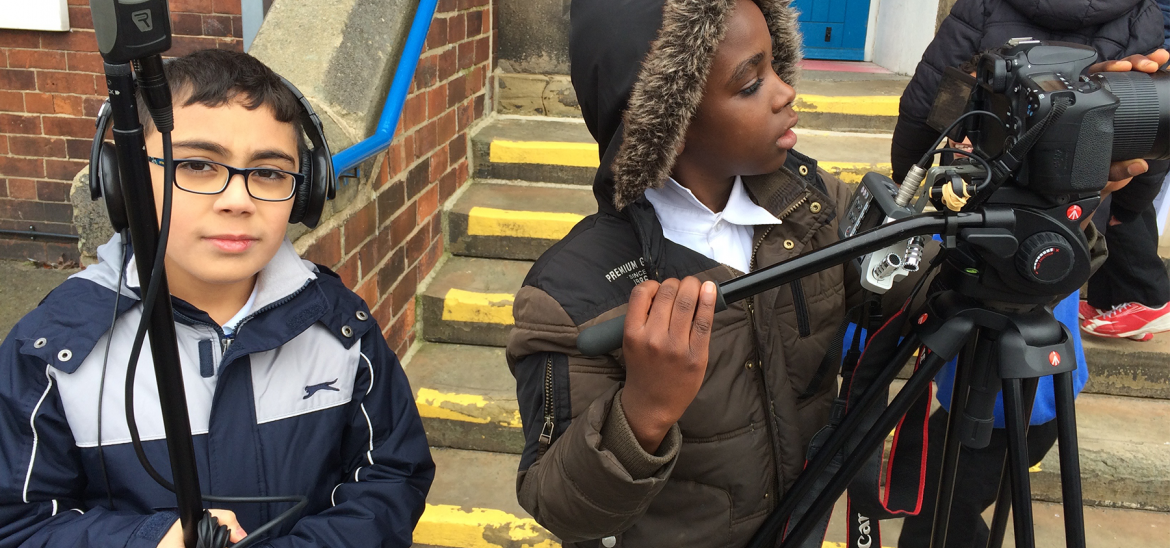Into Film Clubs
Find out everything you need to know about starting an Into Film Club.



Into Film Teacher of the Year 2016 Simon Pile gives his advice on incorporating filmmaking into the classroom in a new three part series. Simon is not only the Assistant Headteacher at Anson Primary School in London, but has also been running their film club since 2009 - so he certainly knows a few things about the benefits of film and filmmaking.
Part two looks at the student as filmmaker, and details why it's so important to give young people a platform for their own voices and ideas to be heard.
I grew up in an era of VHS tapes, where video cameras were often the size of a small microwave oven. Nowadays, students have a film studio in their pocket, as mobile devices contain the tools to film, edit and share their own moving images. App technology gives everyone the opportunity to be directors, animators and actors, and even green screen technology can cost less than £1 using a piece of green paper and a simple app.
It all means that making films has never been more accessible. As teachers, filmmaking has become easier to achieve than ever before.
However, what a film really needs is a story or an idea. In this article I explore one way to generate ideas for films, and share some of the strategies we've used at Anson to get students to bring their films to life.
Ideas tend to be generated by exploring the smallest events in your life. Some of our best short films have been about a paper cut, a ball getting stuck in a tree, or a mouse eating a moon made of cheese.
To get to those ideas, we encourage our children to go on a 'Winding Word Walk'. They think about something they really want to make a film about, such as ice cream, and then use Experience Association - like word association but building on experiences - until they stumble across something else more creative.
For example: I had ice cream at the beach. The beach was full of pebbles. I saw a character called Pebbles in The Flintstones. At the museum I used flint to cut some large sacks. We ran a sack race at Sports Day. It was raining so much during the running race. There was enough water for a boat.
At this point, we reach a 'What If?' moment:
And, in that moment, you have an idea. So how do you capture that idea and turn it into a film?
Most of our filmmaking now happens on the iPad. With iPad technology you can film anywhere, at anytime. You can create pop-up animation studios and capture green screen.
So, let's take our shark infested waters as an idea to explore using four simple techniques.
Cutout animation is a simple technique for producing stop motion animations. It allows students to create flat characters, props and backgrounds, all cut from readily accessible materials such as paper, card, stiff fabric or even photographs. The children can then animate these by moving the pieces on paper, capturing an image after each move.
As long as you are clear on the shots you need, filming at a location, such as your local running track, can be very rewarding for children. We use the local area and the city of London as a backdrop for many of our films at Anson. Using a piece of cardboard as a shark fin and filming a close-up of a fin moving across the running track is more than enough to create the kind of tension you need, particularly when accompanied by a well chosen piece of music.
One of the easiest forms of filmmaking is documentary. The beauty of a news story is that the news crew often arrives after the excitement has happened. This means that with a great interview and a well structured piece to camera, you can leave the details to the imagination of the viewers. It can be shot on location or using green screen technology, or with an app that uses green screen to put the reporter in a newsroom.
Early animation in schools was all about claymation. Skills in model making are important, but always think about what your main goal is when you are making a film, and the time you have available. Do you want your students making films or making models? Toy characters offer more realism and often engage children more, as they can immediately begin filmmaking and telling their story.
The important thing about giving students the chance to tell their story is that you give them a voice. I've met lots of students who are convinced they haven't got any ideas, but by taking them on an experience association using the winding word walk, they always stumble across a 'what if?' moment.
What if you never gave them the chance to explore that idea? What if they never got to tell their story? But, what if they did? Where could that idea take them? Who could see it?
Filmmaking can be very simple, yet hugely rewarding. Try it.
Viewing 4 of 4 related items.

Find out more about our streaming service, designed specifically for UK schools.